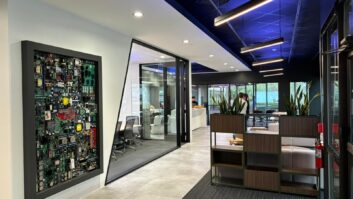I am encouraged to see more and more residential systems integrators including at least some form of acoustical design and treatment in their projects. But while acoustical design and treatments are critical to the performance of any home theater or listening room, they are still one of the most underrated elements addressed in our business.
Lets look at the various different goals of acoustic design and treatment that ideally come into play for a well-designed movie or music space:
1) Prevent sound from outside the room from interferring with the listening experience in the room. This sound can be from within the house and/or from outside the house
2) Prevent sound from inside the room from disturbing those outside the room
3) Isolate sound from HVAC, plumbing, motors and other systems to prevent interference
4) Control sound within the room to maximize the sonic experience, including soundstage, imaging, dialogue intelligibility and uniformity of the experience throughout the listening areas.
For ultimate acoustical performance, all four areas need to be addressed. For even the most basic performance, at least some of these goals should be addressed.
It is an interesting challenge to sell acoustics to residential clients. Commercial clients generally recognize that many elements are required to make up a successful project, including design, engineering, equipment, installation and, yes, acoustical design and treatments. These elements are all part of any successful cinema, theater, performance space, recording studio or movie post-production facility. These clients recognize the absolute necessity of the acoustical aspect and that without attention to this area they will not reap the benefits of a successful facility or business.
Often our foot in the door, so to speak, is a recognized need to achieve some level of isolation. For example, a client says he wants to enjoy the home theater or listen to music at moderate or loud levels without disturbing others, or without even having to worry about disturbing others. Another example is the need to eliminate or minimize traffic or other outside noise so as to not detract from the movie and/or music experience.
Lets consider the range of approaches to acoustics that may be considered. For those who are enrolled in having the best possible results, a dedicated room is always the answer. The room is designed exclusively to its purpose and completely symmetrical, architecturally. Adequate budget is allocated for the design and implementation of an engineered acoustical treatment package, and all construction techniques and materials are specified and employed to that end.
Fortunately, we have at our disposal, a wide selection of products and solutions. The first thing that we do when we can is bring in an acoustical consultant to ascertain project requirements, perform calculations and layout the details for construction, acoustic treatments and finishes for the space. An alternate plan is to utilize the services of a company that offers complete design and execution packages. And if neither of the first two approaches will work, most manufacturers will offer suggestions of how to apply their acoustical products to a specific project, if you send them a drawing of the room.
If a client has absolutely no limits on budget and demands 100-percent isolation, it is possible to offer a combination of extraordinary construction measures. These include building a “room within a room” that is literally floating or otherwise decoupled with the structure in which it is located, especially the floor. The HVAC systems, in this scenario, are completely separate and are designed first and foremost to insure zero transmission of sound in and out of the space. These approaches are utilized for many recording studios and some sound stages where any outside noise would result in compromised productions or increases in costs.
Most people will not choose to spend well into six or even into seven figures just for design, engineering and construction costs for the room itself (not including the cost of the systems and furnishings that will be contained in the room.) And most clients do not really have the need for 100-percent isolation. Something less than 100 percent is generally adequate.
One important policy that we have in my company is to never promise absolute results unless we are in control of all variables. Most people can easily understand that the results of acoustical design and treatment cannot be completely accurately predicted, certainly not within real-world budgets. As I have said many times before, if you want happy customers, promise little and deliver a lot.







